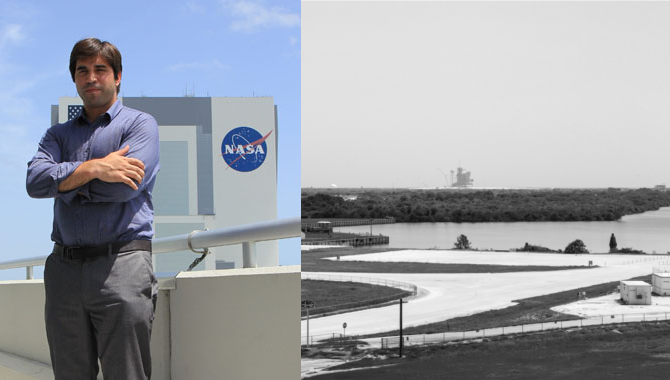
Participants in the APPEL KS International Project Management course pose for a photo at NASA’s Kennedy Space Center as the event draws to a close. Photo Credit: NASA
Participants from 8 space agencies share insights on joint projects.
In late December 2021, the James Webb Space Telescope began performing the most complex deployments ever attempted in space. A massive sunshield comprising five layers of Kapton unfolded to nearly the size of a tennis court. The 18 gold-coated beryllium segments that make up Webb’s 21.3 ft. diameter primary mirror began moving into place, finally aligned to tolerances of about 1/670th the thickness of a piece of paper. With that, commissioning began for some of the most sophisticated instruments ever sent into space.

European Space Agency (ESA) participants posing for a photo. From left to right:
Claudio Galeazzi, Sandrine Palerm, Massimo Palomba, Bjoern Frommknecht. Photo Credit: NASA
The James Webb Space Telescope isn’t just a triumph of aerospace engineering or of scientific ambition, but also of international collaboration. The largest, most sophisticated telescope sent into space—like nearly two-thirds of all NASA’s space-science missions—is the product of successful international collaboration. Webb is an international collaboration among NASA, the European Space Agency (ESA) and the Canadian Space Agency (CSA).
In late February, 47 representatives from eight space agencies, including NASA, gathered at Kennedy Space Center for the APPEL Knowledge Services International Project Management (IPM) course, a five-day learning event in which participants present and discuss the perspectives of different space agencies on effective international project management, sharing insights about what it takes to lead successful cross-cultural, multi-national endeavors.
“The International Project Management course brings together project managers from NASA’s international partners and gives them the opportunity to share the most important aspects of exploratory mission criteria, highlighting strategic project concepts and business processes, sharing cultural norms, and building professional networks,” said Steve Angelillo, APPEL Knowledge Services Deputy Director.
The course curriculum addressed the unique challenges of project management with international partners, such as conflict resolution, cross-cultural communication, and aligning risk management approaches. Through a combination of presentations, case studies, interactive exercises, and a group project, participants gained valuable insights into the nuances of managing projects across borders and cultures.

Participants in the APPEL KS International Project Management course worked on group projects that highlighted the keys to effective international collaborations. Photo Credit: NASA
“NASA’s projects are already complex and challenging, and when you layer another organization’s interests and processes on top of our own, there can be both quantitatively more steps and qualitatively more challenging processes to navigate,” said Tiffany L. Smith, APPEL Knowledge Services Director, and NASA’s Chief Knowledge Officer. “The IPM course introduces these concepts to participants in a highly supportive environment, so they can get hands-on experience collaborating and building relationships with international colleagues.”

Indian Space Agency (ISRO) participants Perumal A.E. (left) and Sura P.S. posing for a photo. Photo Credit: NASA
The course included several NASA leaders presenting aspects of the agency’s approach to program management and international collaboration. This included the history of international collaboration from Apollo to Artemis, how export controls apply to international collaborations, aligning risk management policies, and the importance of knowledge sharing, and lessons learned to program managers.
“We have been lucky to have exceptional speakers highlight aspects of NASA’s approach to program and project management,” Smith said. “Speakers bring their own experiences to bear and share insights candidly, which is essential for helping participants to learn about these topics.”
During the course, representatives from seven participating space agencies—CSA; the German Aerospace Center, DLR; the UK Space Agency, UKSA; The Indian Space Research Organisation, ISRO; the National Centre for Space Studies, CNES; the Japan Aerospace Exploration Agency, JAXA; and ESA—presented summary documents known as quad charts, outlining their agency and key aspects about its approach to international collaboration.
“This approach, which was utilized first by NASA’s knowledge group, is unique, focusing on storytelling, instead of power point descriptions. In a presenter’s own words, they frame the content and connect the dots—highlighting critical areas along the way. It builds a mental picture that is easier to comprehend and remember,” Angelillo said.
“At every IPM, we welcome participants from NASA Centers and representatives from international space agencies who are eager to learn and share their experiences and insights. One thing that made this particular IPM special was the participants’ enthusiasm and excitement about the course, and their willingness to help each other and work together,” Smith said. “We look forward to hearing of many future international project successes from the course alumni.”
To learn more about the APPEL KS International Project Management Course, click here.









